Finally we returned to the Shetland Islands, originally due to go back in 2020 but because of a certain covid pandemic this had to be delayed until now. There are only two ways of getting to this wonderful part of Scotland, flying to Sumburgh Airport or the NorthLink Ferry from the Aberdeen Ferry Terminal to Lerwick. With a Motorhome your choices are obviously greatly reduced.Travelling overnight on the MV Hjaltland in a deck level 2 birth cabin was very comfortable.
 |
| The Shetland Landmark. |
You dock in Lerwick Ferry terminal at 7:30am which allows an early start, plenty of time to drive to Tesco’s on the edge of town, which has plenty of parking, to collect supplies. Opposite is the Fjara Cafe Bar which serves a very tasty cooked breakfast.
 |
| Bressay Ferry. |
One of the aims of this trip was to explore islands that we did not visit in 2019. The first of which was Bressay, a very short seven minute ferry journey from Lerwick. You are unable to book this frequent ferry, introduced in 1976, so just turn up and get in a queue. Avoid busy periods in the week as a lot of folk live on the island and travel to and from work and school on the mainland other than those periods its not a problem getting on the ferry.
 |
| Bressay Boating Club Marina. |
Bressay Boating Club Marina is the only place on the island that provides EHU and water, but has no chemical waste disposal which could have been a real problem if like us you were staying 5 nights! We were given permission to empty our cassette at the toilets at the ferry terminal approximately one mile from the marina. The cost of staying at this very picturesque setting was £10 per night for which an honesty box is provided.
The area adjacent to the marina is called Mail, which coincidently has a wee shop/post office. Originally it had a primary school but this has been converted by the Bressay Development Ltd into a a community hub, which houses the ‘Speldiburn Cafe and Good As New Shop’ along with artist studios and art gallery. Also nearby is the Public Hall and Church and a pier. This was the hub of the island until 1975.
When you approach Shetland by sea you pass the iconic Bressay Lighthouse and this was our first run out with our bikes. The lighthouse, designed by brothers David and Thomas Stevenson, was constructed for the Northern Lighthouse Board and first lit on 31st August 1858. As well as the lighthouse tower the complex comprised a principal keepers house, two assistants keepers houses, engine room and fog horn. Automated in 1989 the light tower was decommissioned and replaced by a flashing LED beacon mounted on the former foghorn tower. As with many other lighthouse complexes the former keepers houses are now self catering accommodation.
On the surrounding land are some derelict cottages and byres that apparently are still being used.
The following day was very windy (not unusual on the islands) and cold so just explored the local area on foot. (Various Photos)
One of the highlights of our trip to Bressay was a visit to the National Nature Reserve on the Island of Noss.
 |
| Office and Living Accommodation on Noss. |
“The island’s name comes from the Norse word for ‘nose’, possibly in the sense of a headland. The Norse who arrived in the 8th century were far from being the first on Noss though – perhaps 2000 years before, Neolithic families had settled here. Islanders worked this fertile land and kept livestock continuously until the 19th century. In 1870 the Marquis of Londonderry leased the island for use as a stud farm. He bred Shetland ponies to work underground in his coal mines in northern England. The restored pony pund, built to house the mares, can be seen next to the buildings near the landing. In 1633 a cradle was strung from ropes connecting Noss to the detached stack of the Holm of Noss. This gave islanders access to gulls’ eggs, but later a larger basket provided carriage for up to 12 sheep. The cradle operated for over 200 years and numerous sketches and narratives were made by visitors and passing mariners. Visitors attracted by the cradle notably included Sir Walter Scott in 1814. Sheep farming continues today on Noss. For most of the year the sheep are free to wander where they choose but during lambing they are brought onto the better ‘inbye’ land to the west of the dry stone hill dyke”. History taken from the ‘Reserve Leaflet’.
After approximately a three miles cycle ride from the campsite you cross the strong currents of the Noss Sound in a small inflatable rubber dinghy handled by a very friendly and capable young lady who stays on the island with a second warden during the season from the beginning of May until the end of August. From the Noss Visitors Centre you follow the six mile coastal walk. Circumventing this beautiful island is quite an experience, with dramatic cliffs that provide suitable ledges for approximately 28000 seabirds who breed there including Gannets and Guillemots. The island has had no permanent inhabitants since 1939.
As foot passengers we crossed the Bressay Sound too Lerwick. As we had explored this interesting wee town on our previous visit in 2019 a quick look around the shops going to collect a few messages and then a lovely walk around Lerwick's Coast Path which we had not completed previously. It takes in the rock formation known as the Knab, through the park to the Sletts and through Breiwick onto, if you have got any sense, the Fjara for lunch, their beef burger is highly recommended.
From here it's a short distance to the Clickmin Broch a prehistoric monument that has been restored at various times since 1861/62 and excavated in the 1950’s.
Our next Island was Whalsey. A 20 mile drive north from Lerwick will bring you to Laxo Ferry Terminal, and then a 30 minutes ferry journey takes you to this rather prosperous island. Lots of expensive cars and impressive new houses due to Walsays fishing industry. Large modern fishing boats anchored in Symbister Harbour are witness to this fact all we were told are owned by their crews.
 |
| Loch of Huxter. |
A short distance from the Ferry Port is the only public house on the island. Situated at Livister opposite the Loch of Huxter the Oot Ower Lounge car park has facilities that allowed us to stay for five nights, including EHU, water, shower and toilet. The pub is open Friday through to Sunday with a Chinese Takeaway on a Saturday.
 |
| Cutting the Peat. |
 |
| Always coming across different things! |
 |
| Stone Shelters Forming Allotments. |
 |
| Britains most Northerly Golf Course. |
Unfortunately the weather was not that reliably, but we did have one really good day which allowed us to explore the island on our bikes, which can easily be done in a day. The ride took us through Isbister , across the island in the direction of Brough. At the top of the island is Britain’s most northernly 18 hole golf course which some spectacular coastal views, a course that appears very popular going by the amount of golfers on its causeways.
Symbister has various things to marvel other than the islands renowned fishing fleet.
The Bruce family acquired most of Whalsay and oppressed the island for over 300 years. But by building the impressive Symbister House bankrupted them selves. Its built of granite blocks quarried in North Nesting shipped across the sound on rafts. Despite the use of forced labour the building cost £30000 a vast amount of coin in the early 1800s. As i intimated the estates finances never recovered and the last resident laird died in 1944. Said to be the finest Georgian mansion in Scotland it is now used as a school. There are various outbuildings and part has been converted into a museum and heritage centre, unfortunately it was not open while we were there.
But one museum that that was available for viewing was the Pier House. Although locked you could get the keys from the well stocked general merchants opposite for a small donation. This building was a Hanseatic bod used by German merchants. The building was restored in 1984. The two floors included replicas of the period and interactive panels tell the history of the local Hanseatic trade. These date from 1557. The most interesting panel reminded me of Brexit and how bad the Scottish people are treated by their near neighbours. I reproduce this for your information:
“The last nail in the coffin of the German trade with
Shetland was the Act of Union between the parliaments of
Scotland and England. In 1707 the English navigation laws came
into force in Shetland, forbidding the import of salt by
foreigners.
In 1709 the justices of the peace in Shetland told the
customs commissioners in Edinburgh that "since the Union
the few Hamburgers and Bremeners that used to come to
Shetland are now so discouraged by the great alteration of
their customs duty that they have all given over their former
trading
On 5 October 1712 John Otto Bossau, who had had a
booth at Hillswick, wrote as follows from his chamber in
Hamburg to the Earl of Morton.
"I have been dealing to Shetland these 15 or I6 years." he
said, "and never had less than three or four ships loading from
thence. I have trusted above £500 every year to the people. I
paid all their duties for them, and if they could pay me it was
well: if not I trusted them, which perhaps others won't do.
And now I am turned out”.
The Whalsay Leisure Centre is situation on the outskirts of Symbister and as well as a gym, an all weather sports field and multi court it has a 15m swimming pool which obviously we took advantage of.
Our next location involved booking three ferry’s. The first ferry obviously had to get us off Whalsey across to Laxo onto Toft and our second ferry across to Ulsta, travelling the length of Yell to Gutcher and then the ferry across to our destination.
 |
| The Original Fetlar Camp Site. |
 |
| Fetlar Hall. |
A wee shock was our first experience of Fetlar. The sat nav and the Ordnance Survey map took us to an abandoned camp site, the only occupants being pigs! But we were soon directed to Fetlar Community Hall with its three modern pitches and the use of the halls toilet and shower. Very clean but with no heating something, along with the constant strong wind, you get used too.
 |
| Angus Lives Opposite the General Store...... |
 |
| and has his own Facebook Page. |
Fetlar is known as the ‘garden of Shetland’ for its green landscape and fertile soils, although some incomers would dispute that and want to enact a new ‘clearance’ this time reducing the sheep numbers which the indigenous population does not apparently agree with. With many boycotting the Saturday social at Fetlar Hall - island politics in action. With under 70 permanent residents its a very quiet island with only traffic coming and going from the infrequent ferry. The island is 7 miles long by 4 miles wide. There is only one shop on the island a General Store coupled with a Post Office and a wee cafe that serves snacks and hot drinks.
Close-by is the informative Fetlar Interpretive Centre which basically tells the history of the island and its people. Well worth a visit helped by its very friendly curator.
Between the centre and the Fetlar Hall is Leagarth House built by Sir William Watson Cheyne who grew up on Fetlar and went on to study medicine at Edinburgh University, becoming a disciple of James Lister and his pioneering work on antiseptic becoming Lister’s House Surgeon. Cheyne conducted experiments on the use of antiseptic solutions in the treatment of wounds spending the rest of his life in a campaign to ensure that antiseptic methods became a fundamental part of modern surgical practice. Often this was against a background of scepticism within the medical establishment. Lots of information and photo’s are on display at the Interpretive Centre. Leagarth is still owned by a descendant of Cheyne’s.
Finally braved getting the bikes off the motorhome to explore some of the island. Travel west back towards Hamars Ness Ferry Terminal and you will come across Brough Lodge and its adjoining Folly. There was plans to renovate the building, so far only a small part of this work has been completed because of financial problems raising the coin to carry out the work. We had been told that the locals would prefer the whole thing to fall down as its original owner Sir Arthur Nicolson was responsible for Fetla’s land clearances. Nicolson was a pioneer in Shetland in evicting tenants from their homes, before he arrived Fetlar was a fertile and populous island. But in the 1820’s he began to prevent islanders from using pasture land and began to create profitable sheep farms instead. During the next 50 years hundreds of men and women were evicted from their houses. 860 people live on the island in 1836, by 1861 only 550 were left.
(For more information see www.broughlodge.org)
Also nearby is the old landing Pier along side part of an original fourareen fishing boat.
Cycle back towards Houbie and take the road that passes the old campsite down to the lovely Tresta Beach which is one of only five beaches in Shetland to receive a Seaside Award each year since 2008, something the community is very proud of. It's a long white sandy beach with stunning cliffs at its far end were you can see nesting birds. Its calm shallow cove makes it ideal for families.
While down at Tresta we took the opportunity to have a look at Fetlar Kirk and its kirkyard where well known local dignitaries are buried.
The present church was built in 1790 on a site which had a Christian presence, which could have been as far back as the 6th century. The Kirk is dedicated to St. Bartholomew who was the least known of the 12 apostles. What we do know is that when he attempted to take the Gospel to Armenia he was martyred by being skinned alive, not sure if that act has got anything to do with the fact that he became Patron saint of tanners and leather workers? Until 2021 Fetlar Kirk was the responsible of the Church of Scotland. When CoS put the church up for sale in 2021 Friends of Fetlar Church purchased the kirk in order to retain it as a place of worship to be used by many denominations including Church of Scotland, Catholic, Episcopalian and Wee worship Iona style services.
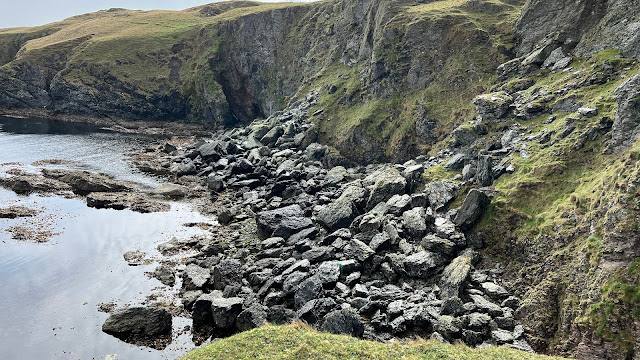 |
| Funzie Bay. |
 |
| Funzie Loch. |
The following day heavy rain and strong wind kept us tucked up in the Motorhome until after lunch when we took a cycle ride up to Funzie Bay, passed Funzie Loch which is famous to all twitchers as home to one of Scotlands rarest breeding birds the red-necked phalaropes. Of course there were none there when we visited!
Counting Noss, that’s four Island’s visited that we did not visit in 2019 now it was back to the mainland via two ferries, the first to Gutcher and then a drive across Yell to Ulsta and across Yellsound to Toft. First stop Lerwick Tesco, even on holiday you have to eat!
Next stop was Skeld Caravan and Campsite on the West Mainland another community run site, still managed by Josephine and Jim Scot. Now we are back on the mainland its a lot busier and Skeld is a very popular site with many English owned motorhomes filling the 19 pitches each night. Located on a marina the site has all the normal facilities that are kept very clean. The cost to stay is £20 per night which up to know seems to be the standard charge, but it will cost you a further £1 for a seven minute shower. There is no TV reception on site but Wi-Fi is free.
First trip out was a circular walk to the Renwick Post Office to collect cash stopping on the beautiful beach to enjoy a picnic as the PO was only open between 2pm until 5pm (3 days a week).
On the way back a wee enjoyable diversion down to the deserted pebble beach and the rock formations at Roe Ness.
Another recommended walk is via Easter Skeld to Wester Skeld, turning right signposted Scarvister. Reaching this point you cross open countryside towards Skelda Ness headland. This 6 mile, not too strenuous, walk and was in total contrast to the battle with the wind on our bikes the following day!
Our 16 mile return bike ride was without doubt an exceptionally hard ride. Firstly the some of the hilly road sections were very steep, but the main problem was fighting the head wind. Even going downhill it was impossible to free wheel, still we got to Waas eventually. The spelling was anglicised to its present form - Walls. Located in the most westerly district of Mainland Scotland this crofting and fishing township has a Post Office/Shop and a direct bus service to Lerwick. A pier was established in the 18th century and Walls became the centre of fishing and fish curing operated by the Shetland Fishery Company, which was managed for a time by Arthur Anderson, co-founder of the P&O shipping company. It's from here that the ferry sails to the island of Foula.
Believe it or not Walls was illegally invaded by 30 Russians in July 1958 for which The Shetland Times gave it a 4 page spread with the sub-headline ‘Red Seaman invade Walls’ It was all to do with an Estonian crewman aboard the Soviet factory ship Ukrania who made a bid for freedom in a motorboat he commandeered ending up on the beach at Walls. Hidden and looked after by locals Erich Keayn was granted asylum by the UK Government. It was a good job Priti Patel wasn't Home Secretary at the time as the poor man would have ended up in Rwanda.
Following our ‘killer bike ride’ too Walls, a short easy bike ride was on the agenda. Wester Wick’s secluded bay is only 3 miles from the campsite and an ideal place to enjoy a picnic on its stoney beach and marvel at the magnificent cliff formations. We were lucky to be joined by a seal who seemed fascinated to stay and watch us eat our piece.
 |
| A Rare Otter spotted swimming in the Marina. |
One of our favourite places in Shetland is Brae. This was another place we stayed in 2019 and fell in love with the town. As we had already explored the area on either bike or foot we decided to have restful stay at the Deltings Marina and not take on too much. The town has a council run swimming pool, very similar to the one at Whalsay, which we made use of a couple of times, the famous Fish and Chip emporium Frankies which is the furthest fish restaurant north. While staying at Deltings we were able to restock from the local Cooperative. Also there is a very well stocked ironmonger’s which sells just about any thing.
The marina can at times be a very industrious place and we were able to watch a boat being lifted out of the water and all the crustaceans removed before being stored on land ready for disposal. The gentleman who owned this had recently passed away when it was discovered that he in fact owned a further nine boats which will have to be taken from their berth’s and stored while the deceased family decide what to do with them!
On a Monday evening there was an influx of local children who were on a six week sailing course run by local volunteers. As you can see from the photo’s the children seem very enthusiastic, enjoying their lessons.
We did however head out for a short walk on a rather nice afternoon heading towards Muckle Roe Bridge. The first thing of interest you pass is the Brae Standing Stone overlooking Busta Voe and the Delting Marina. Legend has it that this large megalith was thrown by the giant of Papa Stour at the giant of Mavis Grind.
Heading further on towards the Busta House Hotel and Restaurant you come across a Doocot. This circular tower built in the 18th century with granite rubble walls, has a very low timber linteled doorway. You can still see flight holes and ledges for the pigeons, usually farmed for the big house kitchen.
Stone built harbour and slipway photo.
According to information from Historic Environment Scotland Busta House was extended in 1714 from an original building that may date back to 1588. It was Thomas Gifford that was responsible for the extended house. The Gifford dynasty ended in May 1748 when the four sons were drowned while rowing across the Voe. Family arguments over the succession lasted for 93 years finally bankrupting the estate. Extended again in 1984 and becoming a hotel in the mid 1970’s.
 |
| North Roe. |
 |
| North Roe Community Campsite. |
North Roe is a small isolated village located at the northern tip in the large Nothmavine peninsula and in fact the most northern settlement on Mainland. Just before you enter the village is North Roe and Lochend Community Hall that offers EHUs, fresh water, chemical toilet drop and a grey water drain - all for £10 per night. Its also a very quiet place to stay, which is the way we like it. Although we got more than our share of wind and rain it did not stop us from exploring the local area.
A walk north following the A970, the last 7 miles of which is a single track road, through the village in the direction of Isbister we were surprised to see a partly renovated 16 seater Potez 840 F-BMCY airliner sitting alongside a private house! It was on Saturday 28th March 1981 that the plane approached Sumburgh, having been diverted from Stornaway, when the pilot had to make an emergency landing when the landing gear did not operate forcing the plane to land on its belly skidding for nearly 300 yards. Fortunately no one was hurt but the plane was beyond repair. Kept at the airport for fire training work until 2005 when it was then decided to scrape the plane because the Sumburgh Airport was to have major development work carried out and it would have been in the way. This was to be the end of the last Potez to have remained in service, that was until North Roe resident Duncan Feather came to the rescue. After long protracted discussions with the construction company working at the airport and equally difficult preparations to get what was left of the Potez back from the extreme southern tip of Shetland to the northern end of Main Island the renovation work was finally underway preserving this rare relic for the future.
The St Magnus cemetery at Isbister has an interesting gravestone made of wood, other than the fact that William Peterson is buried there i could not find out any other information about this interesting gravestone.
Continue north from the cemetery and start, what is said to be, the finest walk on Shetland, and i would not disagree. The undulating walk to Isle of Fethaland has beautifully green pastures and some dramatic seascapes and i must admit was well worth the effort.
On route to the Isle you pass the site of what was once the busiest Haaf fishing station in Shetland. In the 19th century 60 sixareens worked from here with 20 lodges for shore accommodation, the ruins can still be seen.
North Roe has a wonderful community walled garden, with a fine selection of plants that you would not expect to grow in such a wild and windy environment.
On our last night we were invited into North Roe and Lochhead Hall for their plant sale and coffee evening which rounded a very enjoyable stay here.
To reach our next camp site you have to cross the Mavis Grind a narrow isthmus which divides the North Sea from the Atlantic. Eshaness and the district of Northmavine offer more spectacularly striking coastal scenery including a remarkable set of stacks known as The Drongs which can be seen from Braewick Cafe and Caravan Park.
Again this is a busy site, well organised with 10 fully serviced marked out pitches for tourers. Two different price levels are offered, 24 pound per night for a grand sea view or 18 pound per night for a pitch further back. Showers are include in the cost, if only people would clean up after themselves they would be fine. The Cafe is only open 4 days per week because of lack of staff due to Brexit.
Not far from the camp site is the Tangwick Haa Museum which illustrates different aspects of Northmavine life through the years by using a mixture of artefacts and photographs. Also Parish Records and Census Records can be found and viewed there. The Haa of Tangwick was built in the late 17th century for the Cheyne family who owned land in different parts of Shetland including Tangwick.(And as previously noted on Fetlar) The building fell into disrepair in the early part of the 20th century. Part of it was restored by the Shetland Amenity Trust and was officially opened as a museum in 1988. The remaining restoration work was completed in 1999. On the day of our visit the same lovely local lady who we had promised we would return when we first visited in 2019 was working there and made our visit even more enjoyable.
On our walk back we took time out to visit Tangwick Water Mill which was originally restored in 2007/8 by the Hillswick and Eshaness Area Regeneration and Development Association with funds from local associations. Horizontal watermills, of which this mill is a typical example, closely resembled those in Scandinavia. They were common in Shetland in the late 18th and 19th centuries. By the beginning of the 20th century they were in decline, although there was a brief comeback in some areas during the 1st World War when supplies of flour were scarce. Maybe they could make a comeback due to the war in Ukraine and Brexit?
Shetlands weather is hardly ever the same two days running and the following day warm sunshine followed some early wind and rain so the bikes came off.
Stenness has a sheltered anchorage and a shingle beach backed by some grassland which made it an ideal place for a Haaf fishing station, which had up to 40 boats operating throughout the summer. The ruins of a fishing bod can still be seen on the beach. Its ground floor was a combination of store room and shop and the upper level, which had windows and a fireplace, was accommodation for the Lairds representative who would have overseen the fishing operation. It was from beaches like this one that men went 40 miles of the coast in open Sixareens to catch Cod and Ling. The catch was laid out on the beach following preparation and salting.
Dore Holm is a piece of rock formation situated off shore and has a magnificent natural arch big enough for a boat to pass through and is said to resemble a drinking horse.
First though we revisited Esha Ness Lighthouse. This Lighthouse is just one of over 200 that are located around the Scottish coastline operated and maintained by the Northern Lighthouse Board. Designed by David A Stevenson in 1929, this 12 metre high lighthouse ( 61 metres above sea level) was the last manned one to be designed by a Stevenson engineer and has a nominal range of 25 nautical miles.
It was worth a detour down to Cross-Voe-Sand to see the remains of a two story fishing lodge and an interesting chat with a very friendly 83 year ex merchant seaman who was out on his boat in the Hamna Voe servicing his lobster pots before returning and showing us one of his catches. The lobster’s have to be boiled alive because a dead lobster when cooked can release poisonous toxins which would not do you a lot of good apparently!
 |
| Spotted on the walk back. |
Following this rather lovely day the wind returned over night and continued the following morning we did not feel safe using the bikes which was a good excuse to walk the couple of miles up to Hamnavoe and Johnnie Notions birth place were its alleged he was born in 1730. The croft type building has been renovated and is now offered as a camping bod with can be hired by individuals or small groups. Johnnie Nations, whose real name was John Williamson, was one of Northmavines great characters. An uneducated man but one who had an inventive mind designed his own inoculation against smallpox saving over 3000 local people from this 18th century scourge of Shetland, he never lost a single patient.
He is buried in the cemetery which is on the site of the medieval Cross Kirk is dedicated to the Holy Rood and was one of the principal chapels of pilgrimage in Shetland.
Bridge End Outdoor Centre has no mobile phone or television reception, which spared us from the Jubilee nonsense at least. The camping pitches are on a working marina, not one of these posh yacht parking places but a real fishing port where locals actually work.
It was quite exciting watching fish, lobsters and crabs being off loaded. Various boats lifted out of the water for maintenance and/or repair.
But the best entertainment was watching sheep and lambs being loaded on an open boat ready for their summer holidays. ‘Kenneth’ who was organising this rather difficult manoeuvre told us about sheep that were transported to the Island of Noss and took umbridge with their summer digs and swam back across the Noss Sound without, believe it or not, any casualties.
Once you drive on from Scalloway you have road bridges that take you across to Tronda and then onto our latest stop off at West Burra. Staying at Bridge End you have the opportunity to explore some of Burra’s wonderful country side. I would recommend the walk down to Houss on East Burra to experience and enjoy the green and lush country side and the views of Cliff Hills above the stretch of water that separates the island from the mainland.
Also on the East Island is the ‘Outpost’ which flys an Australian flag. Its a strange place to find in this part of the world, a place were you can find emu’s, wallaby’s, pigmy goats, parrot’s, budgerigars, terrapins and a friendly ginger cat.
Take the same trip down West Burra and you're in for even more pleasant surprises. You travel through Papil, which is one of the main ancient Church sites in Shetland, on to Duncansclett and an opportunity to see Easthouse Croft with its thatched roof and outbuildings. Restored in the late 19th century by Burra History Group this is rare example of a surviving croft. It is still used for local community events.
Just on from this croft is a short walk down hill from the car park to a beautiful narrow strip of sandy beach called Banna Minn. Before and after our walk around the headland situated at the head of the beach we sat in some rare sunshine along with families that were enjoying both the weather and a swim in the sea (wet suits were the order of the day - well we are nearer Norway than Edinburgh!)
Also not far from the Outdoor Centre is Sandwick Bay, a quiet inlet were you can relax and sit on the beach watching the activities of seals, We counted 27 of these inquisitive mammals swimming around and warming on the beach. What a lovely relaxing and stress free way to spend an afternoon.
Its a rare occasion to move our Motorhome but it was worth it to drive the short distance to Scalloway. As this was a Saturday and the School Campus was closed we were given permission to park in the school car park.
Scalloway was the capital of Shetland in the 17th century, its castle was built in 1600 by the tyrant Patrick Stewart, earl of Orkney who we have come across previously on our travels. Forcing people to work on the castle abusing his position to serve his own interests - who does that remind you of. But unlike more modern day tyrants Patrick had to answer for his crimes being executed in 1615, not for his oppression of the people but for tax evasion and treason. The castle was garrisoned by Cromwellian troops in the mid 17th century before it was left to fall into ruin.
The village declined with the rise of Lerwick, but had a revival of fortunes in the 19th century with the prosperity of the fishing industry. It is still a very important fishing port and at Port Arthur, beyond the yachting marina is the North Atlantic Fisheries College. Here you will also find Da Haaf Restaurant - highly recommend for its fresh fish.
 |
| An interesting photo before the days of shearing sheep! |
Opposite the castle is Scalloway Museum opened in 2012 by the then Prime Minister of Norway Jens Stoltenberg to coincide with Norways National Day on the 17th May. It is run by the Shetland Bus Friendship Society and is staffed by some very enthusiastic volunteers. Lots of local history can be gleaned from a visit including lots of information about local history, fishing and the exploits of the Shetland Bus heroes.
The Shetland Bus was the name given to operations undertaken by fishing boat crews during WW2 who managed to maintain a route between Shetland and occupied Norway to land undercover agents and supplies for the Norwegian resistance movement and also bring refugees back to Shetland.
By walking the full length of the Main Street you will find of points of interest including New Street, Scalloways oldest street with its colourfully painted houses over looking the Harbour.
Other points of interest include the Muckle Kirk which was built by the Church of Scotland between 1840 and 1842 to serve the needs of the expanding local population and its outlying islands.
Returning to Skeld for a two night stay, a 12 mile drive from the site down some very narrow roads to West Burrafirth to catch the small inter-island ferry for a 9am sailing to our final island on our wish list Papa Stour. Holding only four cars and 12 foot passengers its best to book well in advance. It was quite an exciting 35 minute journey across the Sound of Papa as the sea was a little on the choppy side.
Disembarking we found that the ferry waiting room has tea/coffee facilities and public toilets, it's warm and has lots of information. With no shop on the island best bring something to eat as on a Wednesday you're on the island until the return sailing at 15:45.
The name Papa Stour is believed to have been given to the island by the Vikings . Papey Stora in old Norse means the big island of priests and refers to a community of Celtic missionary priests that lived on the island in the 6th century. By the end of the 13th century the island had become a Norwegian royal farm, the personal property of King Hakon. Although Shetland was pledged to Scotland in 1469 the Lairds of Norway kept their estates on Papa Stour until well into the 17th century. During the 18th century two lairds from the mainland Thomas Gifford and Arthur Nicolson divided the island between them and it remained part of these estates until recently when the crofts passed into private ownership. At one time the population was 351 and is now said to be around 8 people.
Its a beautifully isolated island where you can lose your self for a few hours, but there are some places of interest to see.
Excavations in the 1970s and 1980s at Da Biggins, alongside the only road on the island, uncovered the foundations of a medieval Norse house. In 2008 the Papa Stour History Group in partnership with the Norwegian Craft Academy undertook a partial reconstruction of this stofa. This involved an exchange of students and craftsmen between the two countries. the large log timbers were worked in Bergen Norway using tools and methods typically of the medieval period. They were then shipped across to Shetland before being constructed on site in Papa Stour. The original drystone walls were designed to protect the stofa’s timbers from the prevailing weather. These have been rebuilt on the original foundations with stones found on the site. It was officially opened by the Lady Mayor of Hordaland.
A short distance further up the road is the Papa Stour Kirk built in 1806. Prior to that date the original was a typical place of worship found on Shetland being quite low and bearing a roof of thatch.
 In the west wall of the Kirk is a memorial window to the memory of six Papa men who lost their lives in the Great War. This stained glass window is the only surviving work of painter, stained glass artist and illustrator Victor Noble Rainbird.
In the west wall of the Kirk is a memorial window to the memory of six Papa men who lost their lives in the Great War. This stained glass window is the only surviving work of painter, stained glass artist and illustrator Victor Noble Rainbird.
At the end of the road just before the airstrip is one of Shetlands three mothballed primary schools. The airstrip opened in December 1969 to provide better connections to the mainland and Tingwell. The airstrip consisted of a gravel runway and a timber shed but since April 2021 the airstrip is no longer served.
The best way to appreciate some of the island beaches and caves is to walk back along the coastline.
The tallest of the stacks that cluster around the entrance to House Voe is known as Muckle Fru or Maiden Stack. Legend says that in the 14th century the young daughter of Porvald Poresson who had fallen in love with a low born suitor was confined to a stone house on top of the stack. Eventually she was rescued by her lover who was eventually accepted by the wee lasses family.
Our last stop on our return to Shetland was the South Nesting Public Hall and Campsite situated on the east facing peninsula 14 miles north of Lerwick, another beautiful and tranquil area. The site was opened in 2014 and offers 8 touring pitches each one with electric hook ups and water. A shower room with a toilet is provided in the adjacent hall and a rota of very friendly local ladies keep these facilities spotless.
This is a grand area for walking and a short walk was in order after we set up. Heading east across the hills and down to the shore with its fine view of Hoe Stack and its Lighthouse. Sitting on the shore listening to the sound of the sea and the every present birds must rate as one of life’s pleasures.
Recommended by our hosts was a 4 mile walk known as the loop. A circular route that takes you passed the the Loch of Benston stopping to allow time our to see Catfirth ,the WW1 Air Station then onto to Skellster Store where you can purchase an ice cream and some Sassermaet for tasty Sunday tea. Then right onto the B9075 towards South Nesting Bay and take the first turn on the right and back to where you started. this circular walk.
Some thing we tried this time was use of the SIC Dial a Ride service. We wanted to go into Lerwick for the day without taking the motorhome which meant getting to Nesting Junction to catch a number 23 bus to the Viking Bus Station, hence the Dial a Ride service. Ring the council the day before and they will send transport to get you to and from the junction to coincide with the bus timetable. The only thing is you can not choose the times so we ended up having a rather long wet day in the Shetland capital.
I’ll not bore you with a description of Lerwick as we have already described its main attractions in our blog for Shetland written in 2019 (http://oldage-travellers.blogspot.com/2019/06/shetland-trip-2019.html) The only place we discovered we had not visited was St. Magnus Episcopal Church in Greenfield Place with its wonderful stained glass window above the alter. The centre light is in memory of the Revd John Hunter and was donated by a great great grandson of Hunter. The twelve outer circles were not included in the gift and are therefore of different glass. The centre light depicts the the crucifixion of Christ. Six of the outer circles depict the Agnus Dei, the Pelican and her young, and the symbols of the four Evangelists. The remaining six are of a normal patten.
The long awaited restoration of the Maggie Helen was taking place in the Hays Dock boat sheds where the ship was originally built 120 years ago. The work is being carried by a crew of Shipwrights from Brittany and England.
Sadly its time to leave Shetland so we travelled to Lerwick to embark on our homeward journey.
Just enough time for a short walk around the headland out passed the fire station along the Ness of Sound to see the emergency battery that was established in 1939 during WW2. It was originally manned by 100 Royal Engineers and its role was to protect the outer defences of the approach to Lerwick from sea, air and land attacks.
Our journey back to Aberdeen was longer than the outward journey because the Monday night ferry stops in Orkney but we still docked at 7am at Aberdeen and was off the ferry by six minutes passed which gave us time to get through the town before it gets too busy.
Conclusion.
The weather on Shetland can be unpredictable with strong winds and rain so you have to come prepared. The average summer temperature is around 14 degrees so that should give you a guide as what to expect, but we it did go as high as 15 degrees.
The warmth of the Shetland people certainly makes up for any lack of temperature. Always helpful and prepared to engage in friendly conversation. Shetland is for sure one of the most recommended places in Scotland to visit.
A lot more Motorhomes and campers this time (Middle class yuppie types on their staycations.) Some campsites were busy while others were a lot quieter - thankfully - even having some to ourselves. The off shore islands being the least busy.





























































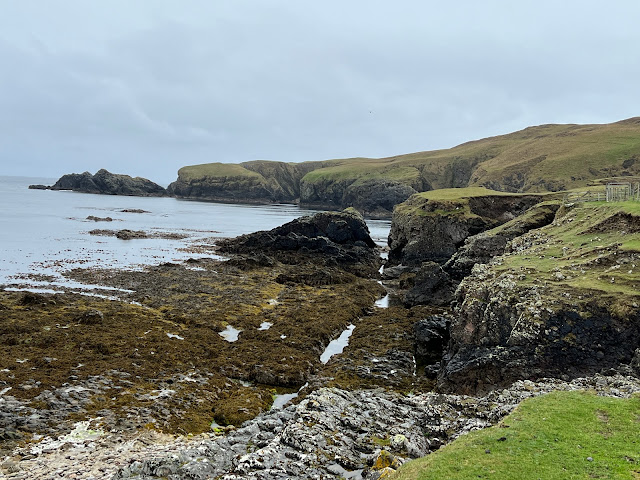






























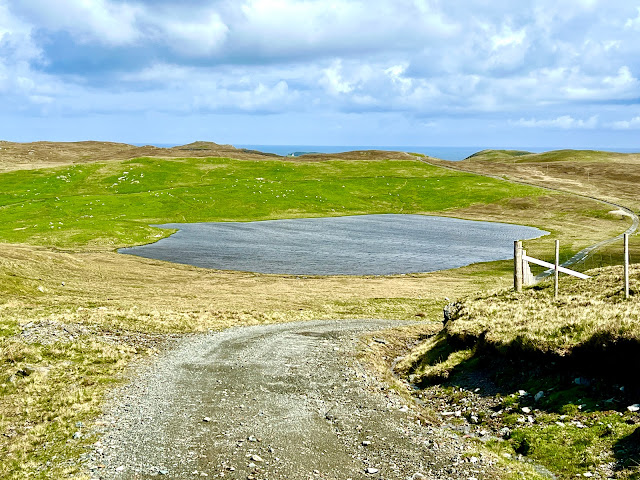






























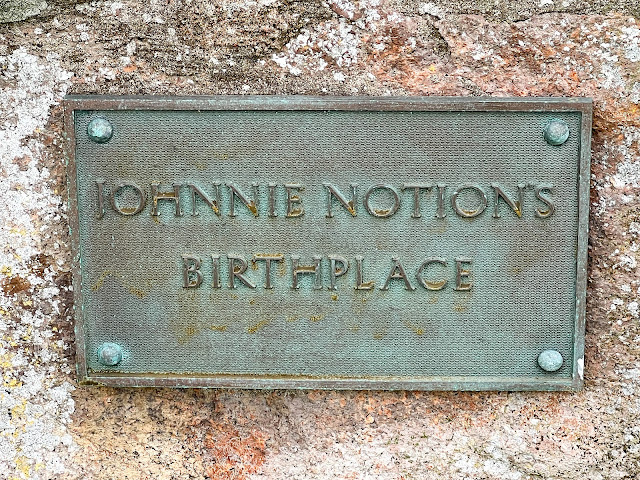








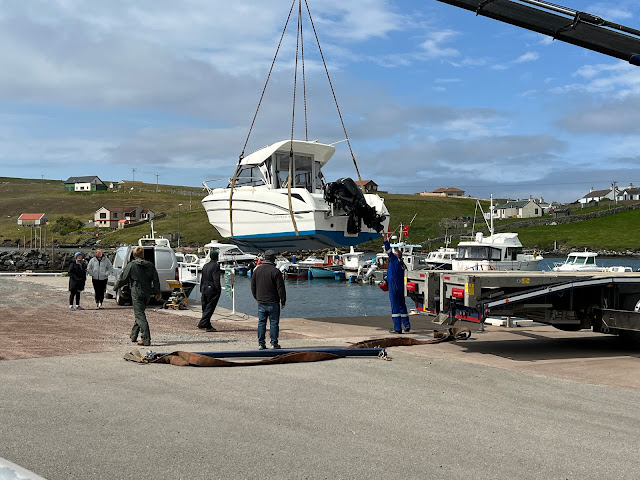

















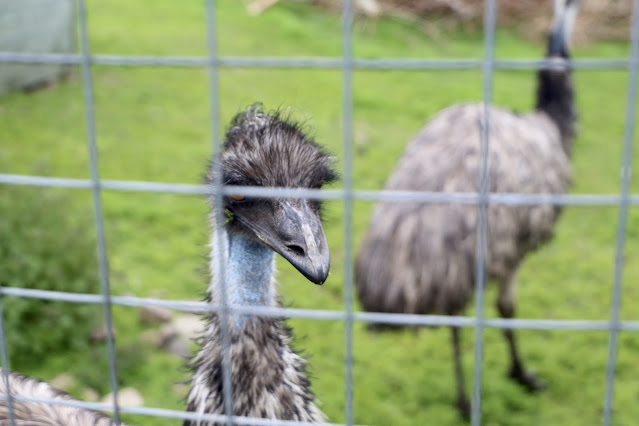











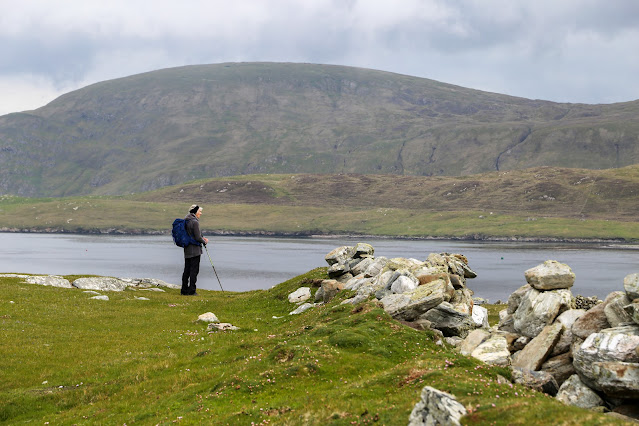
















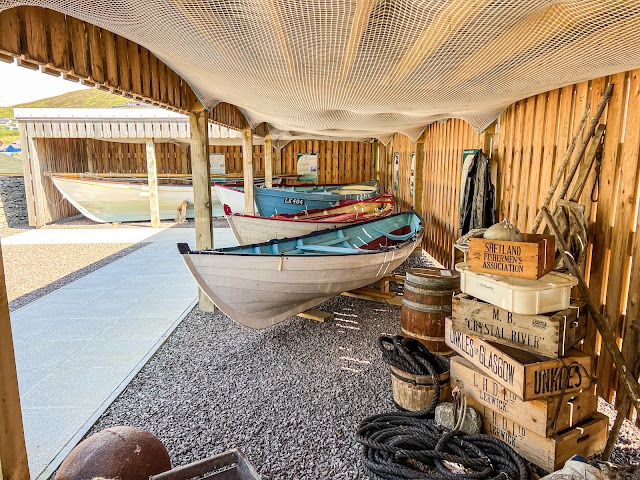














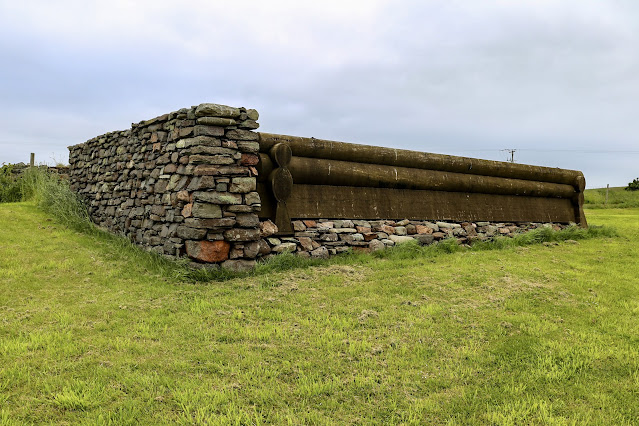












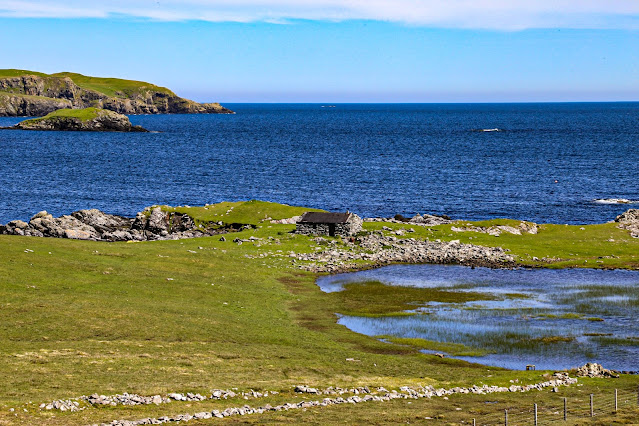














Very interesting read down to The bruc Family acquiring Whalsay, so far, thank oyu & look forward to returning to read on. Neil
ReplyDelete